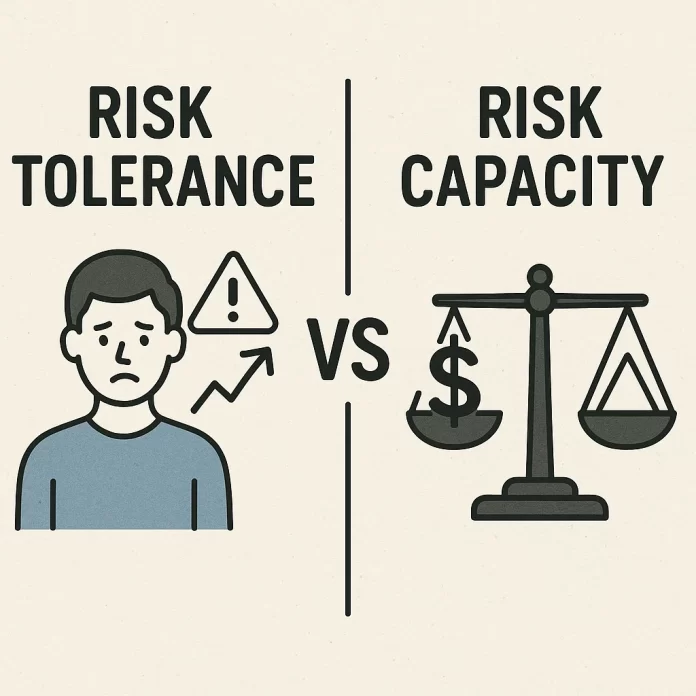When it comes to investing and trading, everyone talks about “risk.” But risk isn’t just a number—it’s personal. Two investors with the same portfolio can experience very different journeys depending on their psychology, life stage, and financial circumstances.
Before putting money into the market—whether stocks, bonds, forex, or even crypto—it’s important to understand two key concepts: risk tolerance and risk capacity. These terms are often used interchangeably, but they describe different things. Together, they form the foundation of any investment strategy.
What Is Risk Tolerance?
Risk tolerance is essentially your emotional comfort level with uncertainty and potential loss. It answers the question:
👉 How much risk can you stomach without losing sleep?
Every investor reacts differently when markets swing. Some people can see their portfolio fall 20% in a week and feel unfazed, convinced it will recover. Others panic at a 5% dip and rush to sell.
Example:
Imagine two friends, Maria and Luca, both invested €10,000 in the stock market.
- The market drops by 15% in a month.
- Maria shrugs it off and even considers adding more money. Her risk tolerance is high.
- Luca, however, can’t stand seeing his portfolio down €1,500. He immediately sells everything. His risk tolerance is low.
Neither is “right” or “wrong”—they simply have different psychological thresholds.
Your risk tolerance depends on:
- Personality: Are you naturally cautious or adventurous?
- Experience: Someone who has lived through multiple market cycles may be calmer during downturns.
- Goals: A short-term trader with clear stop-loss rules may handle volatility differently than a long-term saver.
What Is Risk Capacity?
Risk capacity is your financial ability to take on risk. It answers the question:
👉 How much risk can you afford to take without jeopardizing your financial goals or daily life?
Even if you are emotionally comfortable with market swings, your financial situation may limit how much risk you should take.
Example:
Consider two investors, both aged 40:
- Investor A: Has €200,000 in savings, a stable job, and no debt. He can afford to take risk because even if his portfolio loses 20%, he still has enough buffer. His risk capacity is high.
- Investor B: Has €10,000 in savings, an unstable income, and outstanding credit card debt. Even if he is adventurous by nature, he doesn’t have the financial cushion to absorb big losses. His risk capacity is low.
Risk capacity depends on:
- Income stability (steady job vs. uncertain freelance work)
- Liquidity (do you have emergency savings to cover 6–12 months of expenses?)
- Financial obligations (mortgages, family responsibilities, debt)
- Time horizon (long-term goals like retirement allow more risk than short-term goals like buying a house in 2 years)
Risk Tolerance vs. Risk Capacity: Why Both Matter
A common mistake is to focus only on one side.
- If you have high tolerance but low capacity, you may take risks you cannot financially sustain. Example: trading aggressively with money needed for next month’s rent.
- If you have high capacity but low tolerance, you may keep your money in cash, missing long-term growth because volatility makes you too anxious.
- The ideal scenario is aligning both—understanding not only what you feel comfortable with but also what you can realistically afford.
Bringing It Together: A Simple Framework
Here’s a straightforward way to think about it:
| Factor | Risk Tolerance (Emotional) | Risk Capacity (Financial) |
|---|---|---|
| Definition | How much volatility you can handle psychologically | How much risk your finances allow |
| Influences | Personality, past experiences, mindset | Income, savings, debts, time horizon |
| Example Question | “Would I panic if my portfolio dropped 20%?” | “Can I still pay bills if my portfolio dropped 20%?” |
How to Assess Your Own Risk Tolerance and Capacity
- Ask yourself how you react to losses.
Picture losing €1,000 tomorrow. Do you see it as temporary and manageable, or unacceptable? - Check your financial cushion.
Do you have an emergency fund? Are your debts under control? If not, your capacity is limited. - Match investments to time horizon.
- Money you need in 1–2 years should not go into high-risk assets.
- Long-term goals (10–20 years away) allow for more volatility.
- Take an investor questionnaire.
Many brokerages and advisors offer short surveys to measure your risk profile. These aren’t perfect, but they help highlight blind spots.
Real-World Scenarios
Scenario 1: The Young Trader
Elena, 25, wants to trade crypto. She has a full-time job, no dependents, and €5,000 in savings beyond her emergency fund.
- Tolerance: High—she is comfortable with volatility.
- Capacity: Medium—she can afford to risk some money but not everything.
- Best Fit: Allocating only a small portion (say €1,000) to speculative trades, while keeping the rest in more stable investments.
Scenario 2: The Parent Planning for College
Marco, 45, has two children and wants to fund their university in 5 years.
- Tolerance: Medium—he dislikes sharp losses but can handle some.
- Capacity: Low—because the money is needed soon.
- Best Fit: Safer assets like bonds or a balanced portfolio, not high-volatility stocks.
Scenario 3: The Retiree
Anna, 65, just retired with a pension and €300,000 in savings.
- Tolerance: Low—she doesn’t like stress.
- Capacity: Medium—she has stable pension income, but this capital must last.
- Best Fit: Conservative mix of bonds, dividend stocks, and cash for expenses.
Final Thoughts
Understanding risk tolerance and risk capacity isn’t just theory—it’s the key to building an investment or trading plan that you can actually stick with. Markets will always fluctuate. But if you’ve matched your portfolio to both your psychological comfort and your financial reality, you’re far less likely to panic, sell at the wrong time, or take reckless risks.
Investing is not about avoiding risk altogether—it’s about taking the right kind of risk for you.





